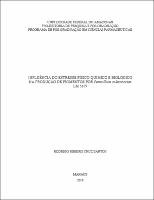| ???jsp.display-item.social.title??? |


|
Please use this identifier to cite or link to this item:
https://tede.ufam.edu.br/handle/tede/7039| ???metadata.dc.type???: | Dissertação |
| Title: | Influência do estresse físico-químico e biológico na produção de pigmentos por Penicillium sclerotiorum LM 5679 |
| ???metadata.dc.creator???: | Santos, Rodrigo Ribeiro Cruz  |
| ???metadata.dc.contributor.advisor1???: | Souza, João Vicente Braga de |
| ???metadata.dc.contributor.referee1???: | Lima, Alita Moura de |
| ???metadata.dc.contributor.referee2???: | Magalhães, Karen Regina Carim da Costa |
| ???metadata.dc.description.resumo???: | Colorantes de origem natural acompanharam o desenvolvimento humano, mas, com o avanço tecnológico, surgiram os colorantes sintéticos, mais fáceis de serem obtidos por não dependerem da sazonalidade comum às plantas, que ainda são as principais fontes de colorantes naturais. Atualmente, os colorantes sintéticos atualmente não são tão desejados, haja vista alguns estudos apontarem tais corantes como causadores de problemas de saúde como alergias, e de problemas ambientais, por se tratarem de substâncias de difícil degradação natural, gerando uma busca para o retorno ao natural. Fungos possuem uma relação milenar na produção de colorantes, é o caso do angkak, um tipo de arroz fermentado por fungos do gênero Monascus, um alimento adotado por alguns povos asiáticos. Na busca por novos colorantes de origem fúngica, em trabalhos deste grupo foram isolados e identificados alguns fungos para esta finalidade, sendo Penicillium sclerotiorum LM 5679 um dos mais promissores, motivo pelo qual se tornou o foco deste trabalho. Este trabalho tem o objetivo de estudar a influência de estresses abióticos e bióticos na produção de colorante. Para estudar os estresses abióticos foi realizado cultivo em meio submerso com análise univariada dos fatores: pH, temperatura, tamanho do inóculo, atividade de água, osmolaridade, velocidade de agitação e exposição a luz. Para os estresses bióticos, foi realizado o mesmo bioprocesso realizando inoculação simultânea, co-cultura, de C. albicans, S. aureus e E. coli com P. sclerotiorum LM 5679. Os níveis de colorantes foram estimados por espectroscopia no ultravioleta visível (UV/VIS), a biomassa de alguns experimentos também foi estimada. Dentre os fatores analisados nenhum superou a quantidade de pigmento produzido no bioprocesso adotado como padrão, os valores mais altos foram obtidos nos testes conduzidos em pH 3 e tamanho de inóculo de 106 células/mL. Os resultados apontam que não há relação entre a quantidade de pigmento e a concentração de biomassa. A importância deste trabalho foi de expor como os fatores de estresse influenciam na produção de pigmento por P. sclerotiorum LM 5679 e, por isso, esses fatores devem ser investigados com foco na otimização do bioprocesso. |
| Abstract: | Colorants of natural origin accompanied human development, but with the technological advance synthetic dyes appeared, easier to obtain because they did not depend on the seasonality common to plants, which are still the main sources of natural dyes. Synthetic dyes are not so desired today, some studies point them as causing health problems such as allergies and environmental problems because they are substances of difficult natural degradation, generating a quest for the return to natural. Fungi have a far relation in the production of dyes, this is the case of angkak, a type of rice fermented by fungi of the genus Monascus, a food adopted by some Asian countries. In the search for new colorants of fungal origin, our research group have been working identifying some fungi for this purpose, being Penicillium sclerotiorum LM 5679 one of the most promising, became the focus of this work. A small curiosity observed during the purification of this fungi was that it had a more intense coloration when it was not pure. This work aims to study the influence of abiotic and biotic stresses on dye production. To study the abiotic stresses, a submerged culture was performed with univariate analysis of the factors: pH, temperature, inoculum size, water activity, osmolarity and light exposure. For the biotic stresses, the same bioprocess was carried out by simultaneous inoculation, co-culture, of C. albicans, S. aureus and E. coli with P. sclerotiorum LM 5679. The concentration of pigments was estimated by UV-VIS Spectrophotometry, the biomass of some experiments was also estimated. Among the analyzed factors none exceeded the amount of pigment produced by the standard bioprocess, the highest values were obtained in the tests conducted at pH 3 and inoculum size of 106 cells/mL. The results indicate that there is no relationship between the amount of pigment and the concentration of biomass. This work presents how the stress factors have influence on the bioprocess, it is necessary more to conduct more investigation focusing on the optimization of the bioprocess. The importance of this work was to explain how the stress factors influence the production of pigment by P. sclerotiorum LM 5679 and should be investigated with a focus on the optimization of the bioprocess. |
| Keywords: | Fungos amazônicos Colorantes naturais Estresse abiótico Estresse biótico |
| ???metadata.dc.subject.cnpq???: | CIÊNCIAS DA SAÚDE: FARMÁCIA |
| Language: | por |
| ???metadata.dc.publisher.country???: | Brasil |
| Publisher: | Universidade Federal do Amazonas |
| ???metadata.dc.publisher.initials???: | UFAM |
| ???metadata.dc.publisher.department???: | Faculdade de Ciências Farmacêuticas |
| ???metadata.dc.publisher.program???: | Programa de Pós-graduação em Ciências Farmacêuticas |
| Citation: | SANTOS, Rodrigo Ribeiro Cruz. Influência do estresse físico-químico e biológico na produção de pigmentos por Penicillium sclerotiorum LM 5679. 2018. 57 f. Dissertação (Mestrado em Ciências Farmacêuticas) - Universidade Federal do Amazonas, Manaus, 2018. |
| ???metadata.dc.rights???: | Acesso Aberto |
| ???metadata.dc.rights.uri???: | http://creativecommons.org/licenses/by/4.0/ |
| URI: | https://tede.ufam.edu.br/handle/tede/7039 |
| Issue Date: | 28-Aug-2018 |
| Appears in Collections: | Mestrado em Ciências Farmacêuticas |
Files in This Item:
| File | Description | Size | Format | |
|---|---|---|---|---|
| Dissertação_RodrigoSantos_PPGCF.pdf | 1.86 MB | Adobe PDF |  Download/Open Preview |
This item is licensed under a Creative Commons License





